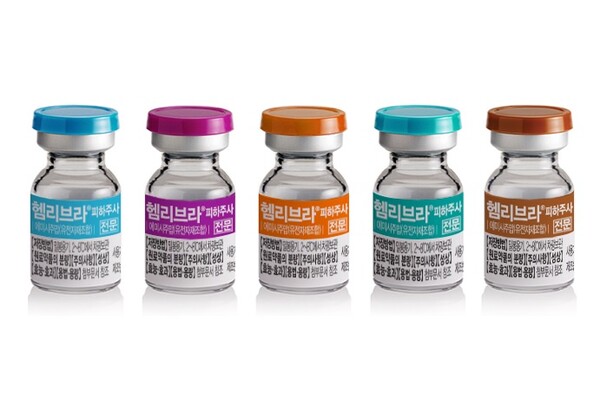
Competition for the hemophilia A treatment market intensifies as GC Biopharma takes a shot at hemophilia A drug Hemlibra (emicizumab) sold by JW Pharmaceutical over safety concerns, and JW Pharm responds with a rebuttal.
On Monday, GC distributed a press release titled "Hemlibra thrombotic adverse event report rate 2.8 times higher than factor-8 agents.”
The study analyzed thrombotic events reported to the U.S. FDA Adverse Event Reporting System (FAERS) between Hemlibra and conventional hemophilia treatments (factor-8 drug).
The study was presented as a poster at the Bleeding Disorders Congress (BDC) in the U.S.
GC said that the analysis of the FAERS database over the past five years (2018-2022) found that out of a total of 2,383 adverse events following the administration of Hemlibra, 97 were thrombotic, accounting for 4.07 percent of all adverse events. In contrast, it added that the proportion of thrombotic events among all adverse events for factor-8 products was only 1.44 percent.
"When comparing thrombotic adverse events in the Hemlibra and factor-8 combination arms, the rate of reported thrombotic adverse events was 2.83 times higher for Hemlibra than for factor-8 combinations," GC said.
GC also pointed out that Hemlibra's high rate of adverse thrombotic events had been raised before, noting that similar findings were published in Europe in March in the news release.
The study, which used the EudraVigilance database, found that the rate of thrombotic adverse events reported with Hemlibra was about 2.77 times higher than that of long-acting (EHL) factor-8 agents.
GC and JW are two leading domestic pharmaceutical companies selling hemophilia treatments. GC had been a significant player in the domestic hemophilia A treatment market, selling its factor-8 drugs GreenMono and Greengene F. and Takeda Pharmaceuticals’ Advate and Adynovate.
In 2020, JW Pharmaceutical introduced Hemlibra, the first non-coagulant-factor drug in Korea, and has since been rapidly gaining market share. From May, it received insurance coverage for non-antibody severe hemophilia A patients.
Against this backdrop, GC suddenly raised questions about the safety of Hemlibra, prompting speculations among market watchers about its intention to keep a major competitor in check.
After releasing the handout, GC clarified that it was simply a case study of a blood clot and was not trying to determine the safety of a particular company's product.
However, by releasing a study highlighting the dangers of another company’s product, the company was effectively trying to brake the growth of a competing product, according to the market watchers.
Some experts also pointed out that GC selectively excerpted only favorable parts of the study and released them to the public.
According to the poster presenting the results of the study, participated in by Choi Bong-kyu, head of data science at GC, Professor Shin Ju-young of Sungkyunkwan University College of Pharmacy, and Yoo Ki-young, director of the Korea Hemophilia Foundation, there were 97 thrombotic events, 4.07 percent of the total 2,383 total adverse experiences (AEs) caused by Hemlibra.
In comparison, 134 thrombotic events, or 1.44 percent out of 9,324 total AEs, caused bv factor-8 agents. Serious AEs, on the other hand, were 1,545 (64.83 percent) for Hemlibra and 7,675 (82.31 percent) for factor-8 combinations, showing a higher rate than the former.
JW hits back, saying factor-8 drugs show more serious adverse events than Hemlibra
As expected, JW Pharmaceutical did not sit still. It released a rebuttal on Tuesday, taking issue with GC’s news release.
JW first pointed out that the FAERS, the source of the data released by GC, is a voluntary adverse event reporting system that does not collect all adverse events of all drugs, dismissing it as data that cannot be verified due to duplicated and underreported adverse events.
It also pointed out that "the number of adverse events relative to the total number of patients treated with each product" is required to compare adverse event rates between products. Still, the problem with the GC presentation is that it only included adverse events reported to the FDA, not the total number of patients treated.
“Therefore, the conclusion that Hemlibra has about three times the rate of thrombotic adverse events compared to factor-8 agents is a logical leap,” JW said.
Instead, the company countered that the number of adverse events was higher for the factor-8 combination than Hemlibra, given that the current U.S. market share is similar (51 percent for Hemlibra vs. 49 percent for the factor-8 combinations, according to IQVIA for the fourth quarter of 2022).
"GC reported 97 thrombotic adverse events for Hemlibra, or 4.07 percent of the 2,383 non-dose related adverse events, and 1.44 percent for the factor-8 formulation, without indicating the total number of adverse events," JW said in its rebuttal release. "According to the poster, the total number of adverse events for Hemlibra and the factor-8 formulation was 2,383 and 9,324, respectively, more than triple the number for the factor-8 formulation. The number of thrombotic adverse events was also higher for the factor-8 formulation, with 97 for Hemlibra and 134 for the 8-factor formulation, indicating a higher number of adverse event reports for the factor-8 formulation."
It went on to say, “In particular, the number of serious adverse events (SAEs) investigated in the same data was 1,545 out of 2,383 (64.8 percent) for Hemlibra and 7,675 out of 9,324 (82.3 percent) for the factor-8 formulation, indicating that both the number and percentage of SAEs were higher for the factor-8 formulation."
JW Pharmaceutical also did not hide its discomfort with GC's move.
"GC directly mentioned and publicly criticized a competitor's drug without taking into account the different times of launch, mechanism of action, and reporting standards of each product," JW said, "We feel sorry about such a behavior that causes unnecessary confusion to patients."

